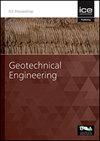Quantitative analysis of the desiccation crack evolution in red clay based on digital image correlation technology
IF 1.7
4区 工程技术
Q3 ENGINEERING, GEOLOGICAL
Proceedings of the Institution of Civil Engineers-Geotechnical Engineering
Pub Date : 2023-09-05
DOI:10.1680/jgeen.22.00186
引用次数: 0
Abstract
Red clay is prone to cracking in desiccating environments. The crisscross cracks compromise the soil structures and induce the instability of slopes. Under natural hygrothermal conditions, a desiccation test of red clay slurry was performed with a self-made device and digital image correlation (DIC) technology to study crack evolution, quantitatively analyse the relationships between moisture content, displacement, strain, and cracks. Results indicate that cracks usually initiate by subdividing and intersect at right angles with other cracks. Main cracks initiate earliest and have the longest duration, with stabilised main cracks being longer and wider than secondary cracks. DIC technology can dynamically monitor crack evolution. Based on strain concentration areas, the location of early-initiated crack initiation and the propagation trend could be preliminarily predicted. The failure strain in cracking was related to the moisture content, and crack evolution was related to the red clay Atterberg limits. The soil shrinkage exhibited anisotropic behaviour, with greater vertical shrinkage at the soil clod centre compared to the edges. In contrast, the horizontal displacement and maximum principal strain at the soil clod centre were smaller than those at the edges. Those findings contribute to providing guidance for formulating engineering geological hazard control measures.基于数字图像相关技术的红粘土干裂演化定量分析
红粘土在干燥的环境中容易开裂。纵横交错的裂缝破坏土质结构,引起边坡失稳。在自然湿热条件下,采用自制装置和数字图像相关(DIC)技术对红粘土浆料进行了干燥试验,研究了裂缝演化规律,定量分析了含水率、位移、应变和裂缝之间的关系。结果表明,裂缝通常由细分而产生,并与其他裂缝成直角相交。主裂缝形成最早,持续时间最长,稳定后的主裂缝比次生裂缝更长、更宽。DIC技术可以动态监测裂纹演化。根据应变集中区域,可以初步预测早期裂纹的起裂位置和扩展趋势。开裂时的破坏应变与含水率有关,裂纹演化与红粘土Atterberg极限有关。土壤收缩表现出各向异性,土块中心的垂直收缩大于边缘。土体中心的水平位移和最大主应变均小于边缘。研究结果可为制定工程地质灾害防治措施提供指导。
本文章由计算机程序翻译,如有差异,请以英文原文为准。
求助全文
约1分钟内获得全文
求助全文
来源期刊
CiteScore
4.40
自引率
4.50%
发文量
68
审稿时长
3 months
期刊介绍:
Geotechnical Engineering provides a forum for the publication of high quality, topical and relevant technical papers covering all aspects of geotechnical research, design, construction and performance. The journal aims to be of interest to those civil, structural or geotechnical engineering practitioners wishing to develop a greater understanding of the influence of geotechnics on the built environment.

 求助内容:
求助内容: 应助结果提醒方式:
应助结果提醒方式:


